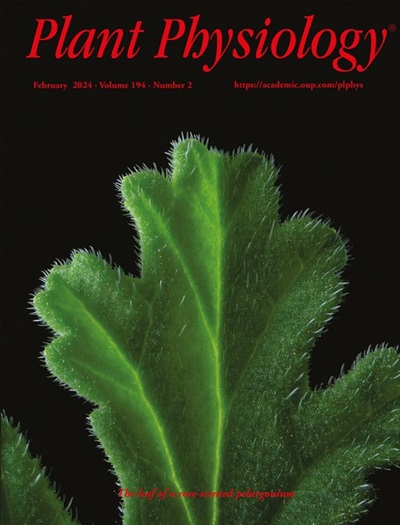马铃薯糖转运体 SWEET1g 影响细胞质糖比率以及块茎和花的韧皮部移动诱导信号
IF 6.5
1区 生物学
Q1 PLANT SCIENCES
引用次数: 0
摘要
马铃薯的主要韧皮部装载器蔗糖转运体 StSUT1 与 SWEET 基因家族的两个成员共同表达:StSWEET11b是SWEET载体的III族成员,假定参与蔗糖外流;StSWEET1g是I族成员,参与葡萄糖外流到凋亡体,与StSUT1有物理相互作用。我们通过荧光葡萄糖或蔗糖类似物的吸收实验研究了 SWEET 载体的功能。抑制或过表达 StSWEET1g/SlSWEET1e 会影响转基因马铃薯植株的块茎化和开花。通过真空渗透离心分离细胞质液发现,细胞质中的己糖组成和单糖与双糖的比例发生了变化,从而影响了沉降强度。下调 StSWEET1g 的表达会影响块茎原 SP6A 和 miR172 在 LD 条件下的表达,从而导致提早开花和块茎化。通过系统筛选与 StSWEET1g 相互作用的蛋白质伙伴,发现了几种影响细胞壁完整性和强度的蛋白质。在块茎发育过程中,StSWEET1g 和主要的相互作用伙伴被强烈下调。我们讨论了 StSWEET1g 的活性是否可能与块茎发育过程中的细胞壁重塑以及从质体到交质韧皮部卸载的转换有关。本文章由计算机程序翻译,如有差异,请以英文原文为准。
The potato sugar transporter SWEET1g affects apoplasmic sugar ratio and phloem-mobile tuber- and flower-inducing signals
The main phloem loader in potato, sucrose transporter StSUT1, is co-expressed with two members of the SWEET gene family: StSWEET11b, a clade III member of SWEET carriers assumed to be involved in sucrose efflux, and StSWEET1g, a clade I member involved in glucose efflux into the apoplast that physically interacts with StSUT1. We investigated the functionality of SWEET carriers via uptake experiments with fluorescent glucose or sucrose analogs. Inhibition or overexpression of StSWEET1g/SlSWEET1e affected tuberization and flowering in transgenic potato plants. Isolation of the apoplasmic fluid by vacuum infiltration centrifugation revealed changes in the apoplasmic hexose composition and mono-to-disaccharide ratio, affecting sink strength. Down-regulation of StSWEET1g expression affected the expression of SP6A, a tuberigen, and miR172 under LD conditions, leading to early flowering and tuberization. A systematic screen for StSWEET1g-interacting protein partners revealed several proteins affecting cell wall integrity and strengthening. StSWEET1g and the main interaction partners were strongly down-regulated during tuber development. We discuss whether StSWEET1g activity might be linked to cell wall remodeling during tuber development and the switch from apoplasmic to symplasmic phloem unloading.
求助全文
通过发布文献求助,成功后即可免费获取论文全文。
去求助
来源期刊

Plant Physiology
生物-植物科学
CiteScore
12.20
自引率
5.40%
发文量
535
审稿时长
2.3 months
期刊介绍:
Plant Physiology® is a distinguished and highly respected journal with a rich history dating back to its establishment in 1926. It stands as a leading international publication in the field of plant biology, covering a comprehensive range of topics from the molecular and structural aspects of plant life to systems biology and ecophysiology. Recognized as the most highly cited journal in plant sciences, Plant Physiology® is a testament to its commitment to excellence and the dissemination of groundbreaking research.
As the official publication of the American Society of Plant Biologists, Plant Physiology® upholds rigorous peer-review standards, ensuring that the scientific community receives the highest quality research. The journal releases 12 issues annually, providing a steady stream of new findings and insights to its readership.
 求助内容:
求助内容: 应助结果提醒方式:
应助结果提醒方式:


